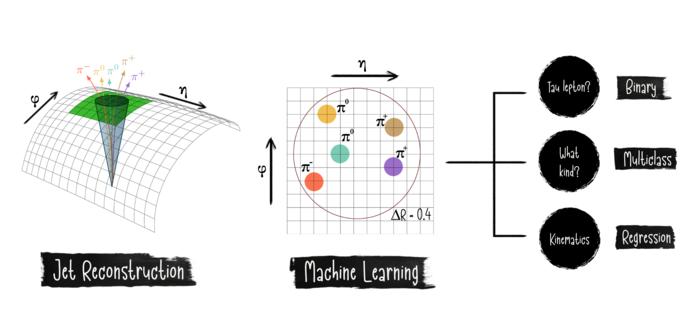
In recent years, significant advancements in computer algorithms have enabled researchers to explore rare processes in collider data, reshaping our understanding of fundamental particles. Among these particles, the tau lepton stands out due to its unique and transient nature. The tau lepton is produced predominantly in processes such as the decay of the Higgs boson. This particle decays into a cascade of low-energy particles, forming distinct jet patterns that can be deciphered to reveal crucial information about its properties and its origin.
Detecting tau leptons poses a challenge due to the complex signatures they leave behind, which require sophisticated analytical techniques for proper identification. Traditionally, scientists employed methods grounded in combinatorics and computer vision to discern these jets from the noise generated by other high-energy particles. This process has relied heavily on expertise in physics, computer science, and advanced mathematics, making it a costly and time-consuming endeavor.
Recent breakthroughs have introduced novel AI models, particularly those based on transformer architectures, to tackle the problem of tau lepton identification with unprecedented efficacy. Transformers, which have revolutionized fields such as natural language processing, have shown potential in analyzing particle jet patterns akin to linguistic constructs. By interpreting jets as sentences in a metaphorical context, researchers can map the relationships and interactions between the constituent particles effectively.
The metamorphosis of jet patterns into a linguistic framework enables these transformer-based models to learn from vast datasets, improving their ability to differentiate between tau jets and more common backgrounds with remarkable accuracy. This new approach addresses the pivotal concern of background rejection, significantly enhancing the performance of tau lepton identification as part of experiments at high-energy physics colliders.
Equipped with state-of-the-art machine learning techniques, the researchers conducted an exhaustive analysis of jet patterns to develop a unified model for tau lepton reconstruction. The transformer model leverages attention mechanisms, allowing it to focus on salient features within the jet while suppressing less relevant data. This capability is especially crucial for extracting the energy distribution of tau particles that decay into multiple daughters.
In their recent publication, researchers demonstrated robust methodologies that surpass previous computer vision methods by capturing intricate relationships embedded in the jet structure. Applying these models in real-time analysis paves the way for enhanced signal detection and improved measurement of decay properties, such as energy distribution and branching ratios. Consequently, tau lepton analyses promise to yield higher precision in experimental outcomes, benefitting future searches for phenomena like double-Higgs production.
The implications of these advancements are profound. As the scientific community delves deeper into the exploration of the Standard Model and beyond, the power of these AI-driven models will likely illuminate pathways to discovering new particles and interactions. This computational revolution signifies a paradigm shift, ushering in new frontiers for both theoretical and experimental physics.
Expanding the reach of such methodologies to other particles in the Standard Model could significantly elevate the sensitivity of future studies. Enhancements in background discrimination and identification could lead to the discovery of elusive phenomena, such as supersymmetric particles or dark matter candidates, thus rekindling excitement in the search for physics beyond the Standard Model. This vibrant intersection of artificial intelligence and particle physics not only elevates analytic capabilities but also fosters interdisciplinary collaboration, with experts from diverse fields converging on shared research goals.
The future looks promising as this research paves the way for the next generation of collider experiments. Advanced machine learning has the potential not only to streamline analyses but also to democratize access to cutting-edge science for researchers worldwide. By lowering barriers to entry through automated techniques, aspiring physicists can leverage these models to contribute meaningfully to ongoing studies, accelerating the quest for answers about the universe.
As we chart the course for particle physics in the coming decade, the integration of AI models will likely redefine our understanding of particles and their interrelations. The strides made in tau lepton reconstruction stand as a testament to the ingenuity and innovation embedded in the scientific process. As we continue to innovate, the synergy of technology and science remains a driving force for discovery, illuminating our understanding of the universe and its fundamental constituents.
In conclusion, the application of advanced machine learning approaches represents a historic leap in the field of particle physics. By redefining how we analyze and interpret collider data, researchers are not only enhancing our understanding of complex interactions but also casting light on the future of particle physics as a whole. With each advancement, we move closer to unveiling the mysteries that lie within the fabric of our universe.
Subject of Research: Not applicable
Article Title: A unified machine learning approach for reconstructing hadronically decaying tau leptons
News Publication Date: 1-Feb-2025
Web References: http://dx.doi.org/10.1016/j.cpc.2024.109399
References: None available
Image Credits: Authors: Laurits Tani, Nalong-Norman Seeba, Hardi Vanaveski, Joosep Pata, Torben Lange
Keywords
Machine Learning, Tau Lepton, Particle Physics, High-Energy Collisions, Transformers, Jet Reconstruction, Background Rejection, Collider Experiments.
Tags: advancements in particle physics measurementsAI models in collider data analysisanalyzing high-energy particle interactionsbreakthroughs in physics data analysischallenges in detecting tau leptonscomplex signatures of tau leptonscomputer vision in particle physicsHiggs boson decay processesinnovative algorithms for particle jet analysismachine learning applications in physicstau lepton identification techniquestransformer architectures in physics research





